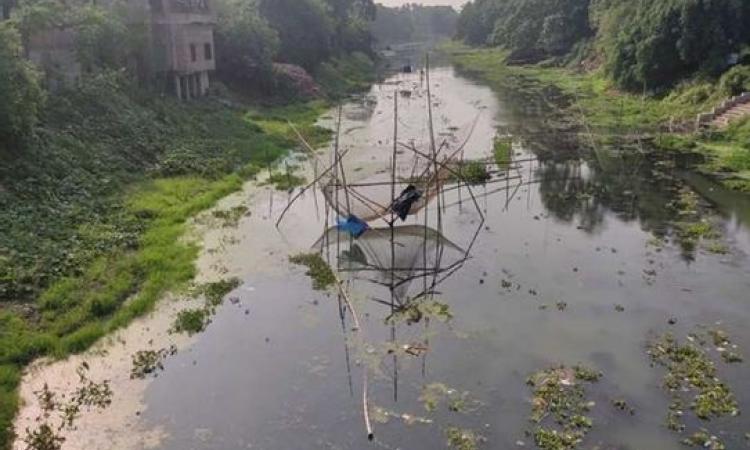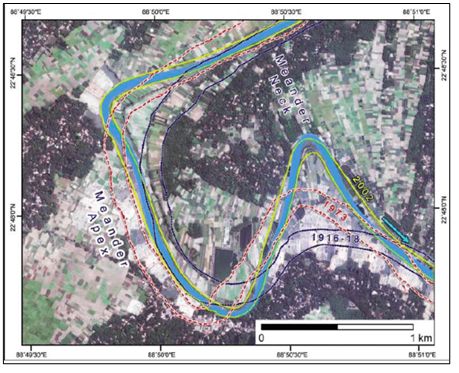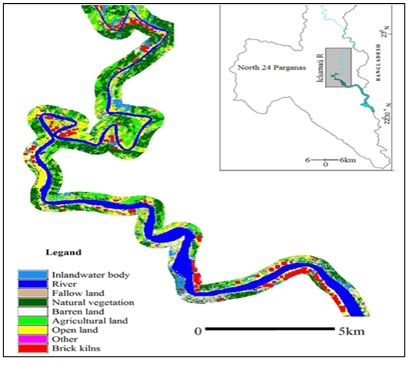
River Ichamati is venerated as a living entity and its fertile flood plains have been catering to the expanding human-mediated demands apart from harbouring an enormous assemblage of aquatic flora and fauna. Ichamati’s rich floodplains directly sustain the livelihoods of indigenous riverine communities coupled with thousands of migrant labourers and refugees residing along and across its basin in North 24 Parganas district of West Bengal.
A study estimates that there are around 200,000 people whose livelihoods are directly dependent on this river. During 1991-2001, many Bangladeshi immigrants permanently inhabited the rural (333,000) and urban (565,000) stretches respectively along the Indian side of the Ichamati basin due to better economic prospects in the agricultural, allied, industrial and tourism sectors.
From a biodiversity perspective, Ichamati is one the of major feeder rivers traversing along the Sundarbans Biosphere Reserve which is a hotspot for 1186 numbers of known irreplaceable biomes including 334 plants, 322 fish and 428 bird species, to list a few. Ichamati swerves through this estuarial ecosystem which is a stronghold for threatened and endangered avian species like white-rumped vulture, masked finfoot, brown-winged kingfisher in addition to the Royal Bengal Tiger, Irrawaddy dolphin, Indian python, estuarine crocodile and river Terrapin.
Owing to erratic weather patterns as a direct consequence of climate change in conjunction with unsustainable and unbridled anthropogenic avarice, the Sundarbans mangrove ecosystem as a whole and most of its linked biodiversity have been marked endangered by the IUCN’s Red List of Ecosystems framework.
Unfortunately, due to the degeneration of river Ichamati as a result of human encroachment along its floodplains and growing levels of water pollution, the sustenance of Sundarbans and its ecosystem services is becoming an alarming imperative from an ecological and economical prism.
There is a need for a clarion call for implementing timely, effective, layered and long-term interventions from the scientific, community and economic angles to save Ichamati and the Sundarbans, by such means protecting its diverse ecosystem and livelihoods of more than 7.5 million people.
Morphological variations in Ichamati along its upstream and downstream
Ichamati is one of the bifurcations of river Mathabhanga and originates at Mahjdia village in the Nadia district of West Bengal. It is a life-sustaining transboundary tidal river that traverses along West Bengal and Bangladesh, covering a distance of around 216 km before discharging into river Kalindi at Hasnabad in North Parganas and finally outfalls into the Bay of Bengal near Moore Island.
From 1916-2020, the channel course of Ichamati’s water has seen sharp changes, majorly due to human interventions apart from historical and geological factors. Several spatiotemporal studies on Ichamati have highlighted concerns about its changing morphology leading to narrowing channel width, changing channel mobility and increasing rate of sedimentation as a combined result of haphazard human encroachments and vagaries of climate change.
Unsustainable anthropogenic activities along its basin have significantly altered its morphology in the downstream. Ichamati’s meander configuration has altered from curved to angular at various nodal points and its channel width has significantly reduced by 2.2 times due to increased sedimentation leading to the growing elevation of the river bed.
Experts think that such morphological alterations have a detrimental impact on the safety and security of the riverine communities as upstream downward areas (north to south) are now more susceptible to monsoon floods due to elevated riverbeds and the incapacity of the river to contain flood-tidal waters.
Over the last decade, areas of Basirhat and Taki have been battling frequent floods and cyclones that even led to collapsing of a concrete dam built on Ichamati, thereby inundating several villages, which rendered 4000 families homeless and threatening the livelihood of several fishing communities who lost their boats to the heavy tidal waves.

As per a 2020 study, changes in the land use pattern to meet the insatiable demand for crop production and export of bricks is one the major human-induced contributors to morphological modification of Ichamati’s channel character and change of discharge. In the upstream areas like Mahjdia, the river channel is narrow wherein local inhabitants have forcefully occupied a large portion of the river basin for agricultural activities (estimated to be around 38%) while this proportion gradually decreases towards the downstream as seen in the picture below.
The height of Ichamati’s riverbed has gradually increased in the upper stretches as tillage for cropping generates loose topsoil that gets transported into the river channel during the monsoon and due to low water velocity, river discharge is not sufficient to flush out the load downstream. Consequently, several patches in upstream have low water depth due to increased sedimentation. This has a detrimental impact on the life-cycle of indigenous fish species which have been the mainstay of livelihood for riverine communities.

Downstream stretches of Hasanbad, Bongaon, Basirhat and Taki have seen a proliferation of brick kilns as its fertile floodplains provide clay-rich fine sediment that is used for forging good quality bricks, apart from the sculpting of idols and pottery. These kilns, in many cases, have forcefully encroached on the banks of Ichamati and are rampantly digging up stretches of the river in an unscientific manner, thereby adversely impacting its natural flow.

Plastic pollution menace and phytoplankton overgrowth
Plastic waste is choking India’s rivers and killing biodiversity, thus making the riverine system- an eyesore of the plastic reservoir. A recent study has also found a positive correlation between river discharge and plastic debris transport through the water system, thereby increasing susceptibility to floods in urban and rural areas situated alongside the river banks.
Ichamati, like many other rivers of India, is showing signs of degeneration owing to multifaceted problems created by humans who have changed this cascading river system to a human interventionist control system. Urban centres along Ichamati are disposing of untreated wastewater, chemicals, agricultural waste, plastic litter, and other pollutants directly into the river.
Due to better employment opportunities, migration across the riverine borderland of Ichamati has seen a surge in the last three decades and as a consequence, high population density settlements have mushroomed up in the areas of Basirhat, Duttapulia, Hasnabad and Taki. River Ichamati, at these nodal points, is faced with the hazard of water hyacinths, phytoplankton overgrowth, plastic and other solid waste litter from domestic, commercial and industrial units along with abandoned, lost or otherwise discarded fishing gear (ALDFG) or ghost gear.
ALDFG along with microplastics is one of the major contributors to plastic pollution in rivers and oceans. On a world scale, 46 per cent of the marine species on the IUCN Red List of threatened species have been impacted by ALDFG, mainly through entanglement or ingestion. Furthermore, a recent study found that marine organisms in the aquatic ecosystem of Sundarbans mangrove forest have been contaminated with microplastics.
Throughout the 216 km stretch of Ichamati, transverse check dams (Badhals) have been illegally built on the river. Substandard quality nylon nets (bearing a short lifespan) are tied on the ends of bamboos that are used to erect the check dams for catching fish. During our field surveys, some of the members of the fishing community agreed that they were not aware of how to dispose off the unusable fishing nets and at times they do discard them in the river directly.
These dams not only hinder the natural channel flow but also contribute to ALDFG and trophic transfer of microplastics in the aquatic systems and their bioaccumulation adversely impacts the riverine biota.
Apart from the plastic menace, Ichamati’s water is exposed to growing levels of eutrophication i.e., overgrowth of phytoplankton, microalgae and macroalgae, due to increasing flows of nitrogen and phosphorous in the water systems as a result of intensive agricultural and industrial activities. This ultimately results in low oxygen or ‘hypoxic’ areas that jeopardise the health of the river, its aquatic life and the surrounding ecosystem.
Local fishermen have pointed to concerns over the deteriorating water quality which is increasingly becoming inhospitable to aquatic life, specifically for immature fish and insects since their life cycle is being dwindled as a consequence of water hypoxia.

Voices from the river
From a socio-economic and human-wellbeing point of view, fishing communities have been worst affected by the decaying state of Ichamati due to the dwindling level of its aquatic fauna. During our discussions with fishing communities, the group unanimously echoed that over the last 60 years the river has become narrower and several indigenous fish species like rayek, bheda and baush have become extinct. Due to low-income prospects, the younger generation has either migrated to cities or downstream urban settlements to work as casual labourers in the brick kiln industry.
Sachin Halder, a 70-year-old marginal fisherman from Duttapulia in Nadia said, “Since the 1980s, Ichamati has lost 90% of its flow. There is hardly any water flow, no fish and choked with plastics it is a shadow of her former self. At present people discard all kinds of things into it including plastics. The fish markets along the riverbank in particular discard thermocol packing material into it. Since the river has very little flow, a lot of the times the discarded items remain stagnant and cause more debris to accumulate around them, ultimately choking up whatever little flow the river has.”
While reminiscing the good old days of the vibrant river Mathabanga, Bishwanath Barman, a local fisherman from Nadia sulkily shares, “Our lives used to be centred around the river. From taking daily baths to catching fishes of gigantic size, Mathabanga was a thriving river with flourishing aquatic flora and fauna. Today due to pollution from upstream (Bangladesh), this river has become unusable and we are forced to extract water from this tubewell for bathing and drinking. If not for the pollution, why would I take bath at the tube well? I will have an immersive and liberating bath in the river instead”.
In the downstream reaches of Ichamati near the Sundarbans Biosphere Reserve, Sundarbans communities shared anecdotes of a few man-tiger conflicts. Reports state that these incidents are becoming recurrent as a result of unprecedented human encroachments leading to habitat degradation, dwindling food supplies and rising temperatures that force these animals to turn towards human habitations in search of prey.
What lies ahead?
In the last few years, the movement to #SaveIchamati gained momentum when a river activist hailing from district Nadia, Sabarna Saraswati, took the matter into his hands and single-handedly started the Ichamati clean-off project. This lone crusader’s mission became a local movement that gathered around 400 local fishermen to undertake the river cleaning task in a 12 km stretch from Narayanpur to Khagradanga village in Nadia.
Such micro-level efforts need to be promoted and upscaled throughout the basin for restoring the river to life but require the collective support and participation of the government, responsible local bodies and community members. Unfortunately, the short-term benefits from such piecemeal approaches fade away with time owing to several political pressures, community distrust due to the spread of misinformation by the miscreants and financial constraints.
The decaying state of Ichamati has been conveniently neglected by various stakeholders mainly because of poor enforcement systems, ineffective land use policy and unrestrained economic activities. Subject experts from India and Bangladesh have been conducting geomorphological and spatiotemporal studies on Ichamati from multidimensional interdisciplinary aspects. Still, their recommendations are required to be implemented holistically to Save Ichamati.
From a geomorphological angle, the evolving nature of unmethodical human encroachments along Ichamati’s floodplains needs to be monitored and effectively traced for executing a well-regulated river basin management plan. Human interventions in the form of the building of bridges, flood control embankments and land use patterns need to be studied more closely to implement interventions that will help in sustaining the natural flow of the river channel by ensuring the required magnitude of meander configurations, water depth, channel width and sedimentation levels for the sustenance of the aquatic biota.
As regards the growing pollution levels, West Bengal State Pollution Control Board (WBSPCB) needs to monitor the implementation of the Plastic Waste Management Rules 2021, Extended Producer Responsibility and Solid Waste Management Rules 2016, specifically in the district of 24 North Parganas from where Ichamati flows. Urban Local Bodies and Gram Panchayats need to play an active role in the effective implementation of these policies on the ground to curtail the alarming level of water toxicity due to such pollution sources.
Also being transboundary, the governments of West Bengal and Bangladesh need to work in tandem to chalk out a transboundary river basin management plan for saving Ichamati from varied sources of pollution, plastic and industrial effluents.
This would require coordinated efforts and cooperation between the technocrats, subject experts, civil society, media house and affected communities from both countries. All in all, the restoration of Ichamati would require a concentrated, layered and structured approach by involving all the relevant stakeholders in both countries.
Author
Akshat Mishra is a policy researcher working in the domain of water-energy-food security in the South Asian region. Presently he is working as a Coordinator, Campaigns at the Water Chronicles. He can be reached at akshat.mishra90@gmail.com
This story is produced as a direct part of the Project Ichamati Kawtha: Climate musings of a transboundary river that aims to strengthen existing evidence, dialogues, partnerships and action on the menace of plastic and other forms of pollution in the transboundary river Ichamati and its linked water systems to enable climate action.